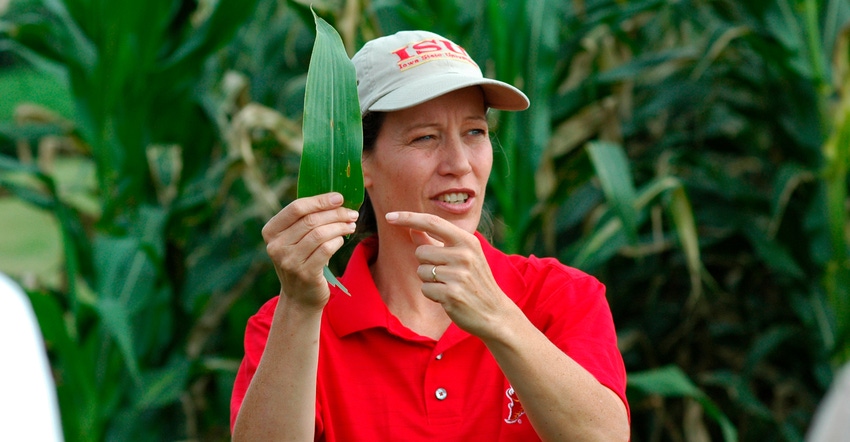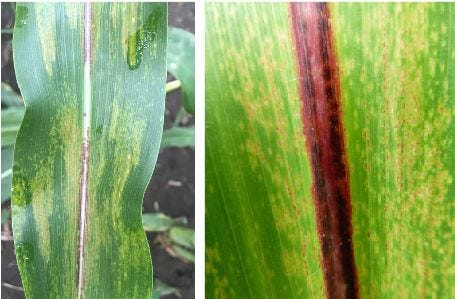July 9, 2018

By Ethan Stoetzer
Be aware of potential corn diseases this year. Given the wet growing conditions over the last month, corn in parts of Iowa will be susceptible to Physoderma brown spot and node rot, caused by the fungus Physoderma maydis. Conditions are also prime for gray leaf spot, caused by the fungus Cercospora zeae-maydis. Following are symptoms to watch for, according to Iowa State University Extension plant pathologists.
Physoderma brown spot and node rot
The risk of Physoderma brown spot and node rot increases when warm (75 to 85 degrees F) and excessively wet conditions result in water pooling in the whorl of the corn plant. The risk rises when this pooling occurs during the early vegetative stages (V3 to V9) of corn growth. The causal fungus produces zoospores that swim through water in the whorl and infect the meristematic tissue.
Given the recent large amounts of rain, coupled with warm temperatures, it is likely that Physoderma brown spot and node rot may be observed in some fields.
• Symptoms. Physoderma brown spot’s symptoms include tiny (about quarter-inch diameter) and round-to-oval lesions that are yellowish-brown. The numerous lesions occur in broad bands across the leaves. In addition, dark-purple to black spots appear on the midrib. These midrib lesions help to distinguish this disease from other corn leaf diseases, such as eyespot and southern rust.

BROWN SPOT: During the middle stages of Physoderma brown spot (left), the spots develop in bands across the leaf, and brown markings appear along the midrib. A more severe case of browning (right) appears along the midrib. (Photos by Adam Sisson and Brandon Kleinke)

Because infection requires a combination of light, free water and warm temperatures, alternating bands of infected and non-infected tissues commonly develop on the plant. Symptoms may also appear on the stalk, leaf sheath and husk.
Physoderma node rot symptoms are recognized as snapping off of the cornstalk at one of the lower nodes (usually sixth through eighth) during the midreproductive stages (R3 to R5). The node is often rotted, but the pith is not. Orange spores may be easily rubbed off the rotted node, or the leaf sheath attached to the rotted node.
Younger plants are more susceptible to this disease and become more resistant with age. The causal fungus overwinters in infected host tissue or infested soil for several years.
• Management. The best time to scout for Physoderma brown spot is during the V12 through R1 stages of growth, and R3 to R5 for Physoderma node rot. The disease may be more prevalent in fields with infested corn residue or those with a history of the disease. Corn hybrids vary in susceptibility to Physoderma brown spot and node rot.
There are no in-season management options for Physoderma brown spot and node rot. Although some fungicides are labeled for Physoderma brown spot, field trials at Iowa State University have not shown a reduction in disease, nor have these fungicides provided yield protection.
Gray leaf spot
Warm temperatures (75 to 85 degrees) and relative humidity greater than 90% favor gray leaf spot development. Symptoms of the disease are most likely to appear following long periods of heavy dew and overcast conditions, and in bottomlands and fields adjacent to woods where humidity can be very high.
In Iowa, you typically see gray leaf spot start to develop around tasseling time. Because of weather conditions this growing season, however, it is likely that gray leaf spot may start to develop prior to VT stage or tasseling.
Gray leaf spot is a disease that can be more severe when corn follows corn in the same field. It also can be more severe in reduced or no-till systems. The fungus survives in corn crop residue, and spores are spread by wind and splashing rain. The susceptibility of the corn hybrid and weather conditions will strongly influence disease development.
This means that gray leaf spot can be locally severe but not cause widespread damage throughout a region. For corn that was planted late, there is usually an increased risk for disease that could result in higher levels of infection and potential yield loss.
• Symptoms. Gray leaf spot lesions begin as small, oval or jagged light-tan spots that expand to become long, narrow and rectangular. The lesions are always confined by and expand parallel to the leaf veins. Later infections may turn gray. Depending on the hybrid, the lesions may be surrounded by yellow or orange halos. Gray leaf spot always begins in the lower canopy of the corn plant and progresses up the canopy. Yield loss will depend on disease severity, and much of the upper plant canopy is affected.

GRAY LEAF SPOT: Look for small, oval or jagged light-tan spots that expand to become long, narrow and rectangular. Later infections may turn gray.
• Management. Managing gray leaf spot begins with selecting resistant hybrids for fields where the disease commonly occurs. Inoculum levels may be reduced through rotating crops and reducing the amount of crop residue on the field surface by using residue management practices.
Application of foliar fungicides are usually effective at managing this disease. Time of application is important. Applications made in the very early stages of disease development (few lesions in the lower canopy) are more effective at slowing the development of this disease and protecting yield.
More information on corn diseases
To help identify, scout and manage corn diseases, check out the booklet Corn Diseases, IPM 5, published by ISU Extension. The publication provides recommendations for management, along with identification and scouting information. Also included are illustrated disease cycles for primary diseases, a foliar disease estimation chart, and corn growth, development and staging information.
Stoetzer is a communications specialist with ISU Integrated Crop Management Program.
You May Also Like




